#gleets
Text
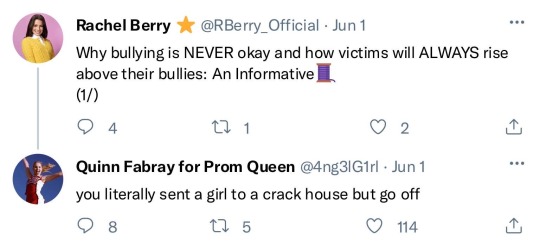
137 notes
·
View notes
Text







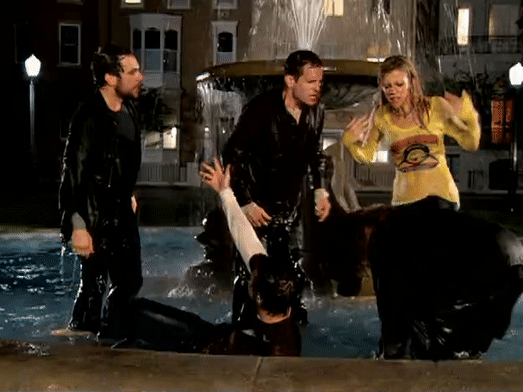


It's Always Sunny in Philadelphia - "Friends"
↳ Dennis + The Gang being "friends"
#iasip#it's always sunny in philadelphia#dennis reynolds#charlie kelly#mac mcdonald#dee reynolds#frank reynolds#i'm sorry for gleet (glenn feet)#i mostly just wanted a gif of dennis slapping frank's bald head#and the charden hug#because i found it on vimeo posted by the actual director of the promo#and it's not COMPLETELY atrocious quality like the one on youtube#deandra reynolds#the gang#ada speaks#ada's gifs
3K notes
·
View notes
Text
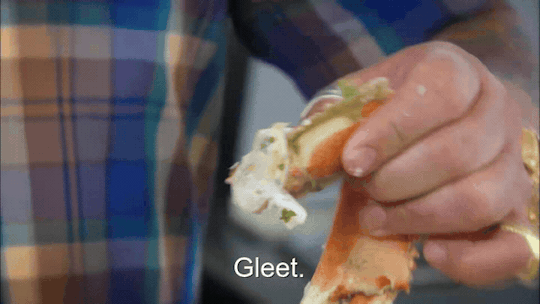
[Gleet.]
4 notes
·
View notes
Text
You know how the cockatrice is said to hatch from a roosters egg and that seems silly because roosters don't lay eggs?
Well, they actually hatch from cock eggs. Which is of course the other word for rooster, but in this context a cock egg, also known as a wind egg or fairy egg, is a very small egg that doesn't contain a yolk.
To prevent one from hatching you were supposed to throw the cock egg over the house to smash it without hitting the house.
#aka i found one today and was looking stuff up to make sure something wasnt wrong with my hens#i already have one sick one (frenchie got vent gleet again)
17 notes
·
View notes
Text

gleet gleet gleet gleet gleet
2 notes
·
View notes
Note
Why is it called peanut butter?
Because "Skunk Gleet" was inaccurate and unpalatable.
269 notes
·
View notes
Text

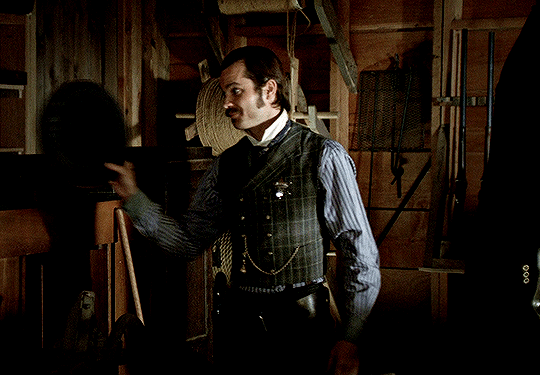
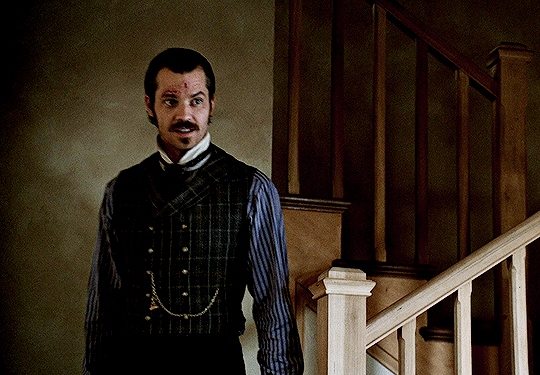



Timothy Olyphant as Seth Bullock
DEADWOOD — 2X04 — “Requiem for a Gleet”
168 notes
·
View notes
Note
anitv Jake did WHAT
OP refers to these tags #4d chess psychological warfare#like that time in anitv jake acquires tom and successfully talks a bunch of controllers into shooting the real tom
The episode "Face/Off Pt. 3" is a classic combination of AniTV having some plot ideas with fascinating potential... and then executing those ideas so badly the show is nigh-unwatchable.
Various Animorphs are running around the yeerk pool, (Rachel is in Tobias's brain as a yeerk to defeat the Gleet Biofilter, speaking of cool ideas that got wasted) in the season finale. Jake drags Tom into a back room, and when the controllers break down the door, there are two identical copies of Tom standing there. It's kinda cool that the audience also doesn't know which one's Tom and which is Jake, because both of them immediately start shouting about how the other one is an imposter and the controllers should shoot that guy.
For the rest of the episode — which switches to focus on how Marco collapses the entire yeerk pool cavern by pulling down a single ceiling tile and throwing it against a pillar (go figure) — there are two copies of Tom running around. There's some dramatic tension when we see one of the Toms get crushed to death by falling rubble and don't know if Jake just died, as well as in a later scene where one of the Toms walks in on Cassie mid-morph. That Tom demorphs into Jake, has the honestly kinda funny line "Phew! My parents were about thirty seconds away from having a set of identical twins." Original flavor Tom is dead in the basement, but that's fine, because the Animorphs are off to a dance party. Also, Tom's back two episodes later with no explanation because Melissa Chapman needs a boyfriend. Sigh. So much potential, so badly wasted.
#animorphs#anitv#jake berenson#tom berenson#yes i know there are *glaring* plot holes and character inconsistencies in this concept#including tom not recognizing jake as jake is standing six inches away and talking directly to him#including jake casually trying to get tom killed after proving willing to let cassie maybe-die to save tom in an earlier episode#but i still think it's a really cool idea that i wish we'd seen k.a. applegate explore in animorphs canon#with good writing and coherent plotting and all
203 notes
·
View notes
Text
Yoko: so Willa
Wednesday: the fuck you just call me
Yoko: ummm. Willa you know like eni-OH SHIT! Im so sorry I'll never say it again all though we have to figure out some nick name for you
Wednesday: if you insist on some stupid nick name, I guess Wendy will do.
it's what my old friend group called me
Yoko: old friend group ?
Wednesday: yes I had friends before Enid all though we haven't talked much
Enid: YOU HAVE FRIENDS!
NAMES NOW!!!
Wednesday: ok ok I will tell you chill
My first...friend...I had was Lynda gleets
Then there was Lyla and Kyla
After that there was Joel Glicker
Then the final friend I had before here was Sam Sedgwick
OH! Wait almost forgot about Parker Needler met him at the same time I met Lyla and Kyla
Enid: you'll see them all here tomorrow mark my words
Wednesday: Enid I have no way to contact them I doubt you do
Enid: oh don't worry I have my ways.
Wednesday: sure Enid sure
Bianca: you'd be surprised what Enid can do
Wednesday: any other person I would honestly write off but your the most sane one here not like it's a challenge though but anyways the fact that it's you saying that has me worried
Divina: Damn even Wednesday is on the train of when Bianca says something happened it almost certainly did
Yoko: that has to be the most shocking revelation yet, and Wednesday said she had friends before us
Enid: wait us, as in She considers us friends
Everyone (some very demeaning): Aww Wednesday
Wednesday (blushing glaring): I'm leaving goodbye
Everyone:

#Wenclair#wenclair#wednesday addams#enid x wednesday#incorrect wenclair#wednesday is soft for enid#eniday#wednesday x enid#wednesday and enid#wednesday on netflix#wenclair incorrect quotes#Willa's pals
256 notes
·
View notes
Text
Been a while since I’ve updated on the cheeps! In the spring some of my hatchery stock get poopybutt (it’s really called vent gleet but I dislike the word and the clinical explanation is also icky). So they all get medicated and a big helping of Greek yogurt.
So please enjoy the yogurt buffet and may your bum be healthy.
66 notes
·
View notes
Text
When Desire Stops Being The Villain
I’m currently re-reading (for the felt 100th time, and I might not even be far off 🤣) “Brief Lives”, both for a meta I have in the making and also for the sequel to my fic.
And we are so often talking about how deliberate Dream (and by extension Neil Gaiman) is in the choice of his words. And as I said, I’ve read Brief Lives so many times, but this time, I’ve done it specifically with the conceptual sibling relationships in mind, and I’d just like to draw attention to this panel:
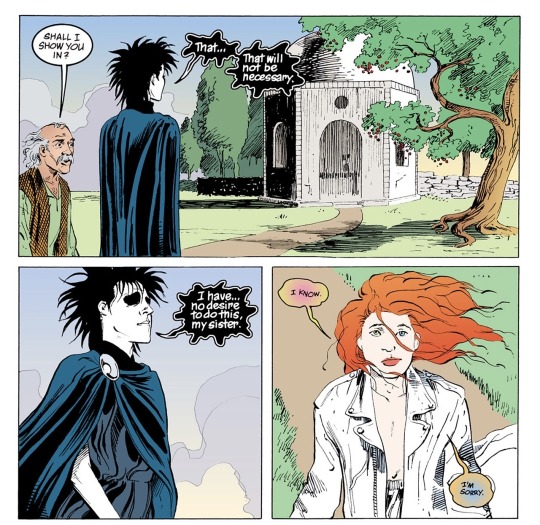
Dream very explicitly says, “I have no desire to do this, my sister.”
Very often (and probably also deliberately due to a) who he is and b) the strained sibling-relationship), he will choose words like “wish” instead. But here, he speaks of the absence of desire.
And you cannot tell me that’s not a deliberate choice of words. If we look at this conceptually, and think about how Desire wants to lead him into his downfall, we see a very notable change throughout the whole arc of Brief Lives:
They warned him at the beginning not to go with Delirium (“tell the little gleet to buzz off”)
They told Tiffany that they tried to talk sense into him, but he wouldn’t listen (that whole thing about not having the sense to come in from the rain)
After Dream killed Orpheus, Despair tells Desire it’s not their doing (and there’s also significance here that they meet in Despair’s realm, not the Threshold). And they admit they should feel elated he spilled family blood, but that they don’t. That they thought it’s what they wanted, but they didn’t. That they’re scared.
And then they proceed to float in an eyeball to basically mourn (and what and whom they think about is set up to be a bit ambiguous, but it truly isn’t).
But back to the panel:
Desire is not there. They are not part of the plan to spill family blood anymore, like they were with Rose (which also isn’t straightforward; I wrote about this before in a roundabout way).
They are not part of Dream’s final descent. The final nails in the coffin all come from Dream himself (and are mirrored, as we all know, in his relationships to Delirium, Destiny and Destruction at this point. Despair and Death are obviously in there to, but more after the fact, so to speak). Well, to be frank, they always did.
But the one either being notably absent or actively trying to prevent Dream giving in to Delirium (see what I did there?), seeking Destruction or talking to Orpheus is the supposedly least likely candidate. The one we so often think would want Dream to do all these things so it leads to his demise.
I’m not saying that the others don’t have their moments. Both Destiny and Destruction do in a roundabout way, but conceptually, they just aren’t particularly helpful for someone in Dream’s state of mind. And of course Del with her moment of clarity when she gets him up from falling to his knees in Destiny’s garden. But there is more metaphor than you can shake a stick at in that one, too, and conceptually, the message is not straightforward. Because it gives us a lot to think about if Delirium, clear or not, gets you back on your feet after you buckle under the weight of what you are supposedly… destined to do, but that just as an aside.
Desire’s and Dream’s relationship is so complex (as are all the sibling relationships), and I’d just like to encourage everyone to have the occasional stab at reading all these bits through a slightly different lens, and understanding that their relationship is not just straightforward hate.
It’s incredibly tragic, and I feel inclined to say for both.
#the sandman#dream of the endless#desire of the endless#sandman comics#sandman#sandman meta#morpheus#brief lives#sandman bookclub#delirium of the endless#orpheus sandman#sandman spoilers#brief lives spoilers#the sandman comics spoilers
79 notes
·
View notes
Text

88 notes
·
View notes
Text
Marat Resources Masterpost:
Author's Note: This list is limited to Marat's own works and less-negative portrayals from various historians. There are ample books and historians that depict Marat in a negative way that are easy to find. There has been a bit of work done to show Robespierre in a less negative way in the field, but most of the works about Marat that don't just echo Thermadorian propoganda are much older (like pre-Cold War). Also, in attempt to make this as accessible as possible, most of these sources are public-access or can be found through JSTOR.
I'll be adding more dates and sources as I progress in my own studies, but I hope this offers at least a starting point.
Marat's Own Works:
Pre-Revolution: Scientific and Medical Works
Essay on Gleets (Gonorrhea) (1775) and An Inquiry Into the Nature, Cause, and Cure of a Single Disease of the Eyes (1776) (English Translation from 1891)
Recherches Physiques sur le Feu (English: Research into the Physics of Fire) (1780)
Découvertes sur la Lumière (Discoveries on Light) (1779)
Recherches physiques sur l'électricité (Research in Physics on Electricity) (1782)
Mémoire sur l'électricité médicale (1783)
Discoveries of M. Marat,... on fire, electricity and light, confirmed by a series of new experiments. (1779)
His French Translation of Newton's Optics (1787)
Pre-Revolution: Political/Other Works
A philosophical essay on man: Being an attempt to investigate the principles and laws of the reciprocal influence of the soul on the body. (1773)
De l'homme ou des principes et des lois de l'influence de l'ame sur le corps, et du corps sur l'ame. (1775)
Plan de législation criminelle. (1780)
The Chains of Slavery: LES CHAÎNES DE L'ESCLAVAGE (1791 French Edition)
Chapter 1 Introduction
Chapter 2 Avilir les peuples.
Chapter 3 Diviser la nation.
Chapter 4 Des esprits satiriques.
Chapter 5: Vains efforts du peuple.
Chapter 6: De la guerre étrangère.
Chapter 7: Coups d'etat.
The Chains of Slavery (1774 English Translation)
Early Revolution:
Offrande à la Patrie (Offering to the Nation) (first published anonymously in February 1789)
"Supplément de l'Offrande" (1789)
L' Ami du Peuple:
L' Ami du Peuple (September 1789-1793)
L' Ami du Peuple continued
Some Specific Parts of L' Ami du Peuple:
"Jews, Executioners, and Actors" (from No. 77, December 25, 1789)
"Illusion of the Blind Multitude on the Supposed Excellence of the Constitution" (from No 334, January 8, 1791)
“Freedom is Lost” (from No. 625, December 14, 1791)
“What Men Are More Vain than the French?” (from No 671, July 12, 1792)
"To Camille Desmoulins"
"Corruption of the National Assembly"
"Denunciation of Necker"
"On the King's Dismissal of Necker"
"Conjurations of all Enemies to the Revolution with Lafayette"
"Observations of the Hate Raised Against Him"
Post-humously Published Works:
The Adventures of Young Count Potowski, Vol. 1 (published in 1848)
The Adventures of Young Count Potowski, Vol. 2
From Historians on Marat:
Marat: THE FRIEND OF THE PEOPLE (Bougeart, 1865?)
"The Radicalism of Jean Paul Marat" ARTICLE (Gottschalk, 1921)
Jean-Paul Marat: The People's Friend (Bax, 1900)
Jean-Paul Marat: A Study in Radicalism (Gottschalk, 1927)
Jean-Paul Marat: Tribune of the French Revolution (Conner, 2012)
Jean Paul Marat: Scientist and Revolutionary (Conner, 1997)
#french revolution#french rev#jean paul marat#marat#resources#masterpost#l'ami du peuple#frev#sources
115 notes
·
View notes
Text
Why Regret?
by Galway Kinnell
Didn't you like the way the ants help
the peony globes open by eating the glue off?
Weren't you cheered to see the ironworkers
sitting on an I-beam dangling from a cable,
in a row, like starlings, eating lunch, maybe
baloney on white with fluorescent mustard?
Wasn't it a revelation to waggle
from the estuary all the way up the river,
the kill, the pirle, the run, the rent, the beck,
the sike barely trickling, to the shock of a spring?
Didn't you almost shiver, hearing book lice
clicking their sexual dissonance inside an old
Webster's New International, perhaps having just
eaten out of it izle, xyster, and thalassacon?
What did you imagine lies in wait anyway
at the end of a world whose sub-substance
is glaim, gleet, birdlime, slime, mucus, muck?
Forget about becoming emaciated. Think of the wren
and how little flesh is needed to make a song.
Didn't it seem somehow familiar when the nymph
split open and the mayfly struggled free
and flew and perched and then its own back
broke open and the imago, the true adult,
somersaulted out and took flight, seeking
the swarm, mouth-parts vestigial,
alimentary canal come to a stop,
a day or hour left to find the desired one?
Or when Casanova took up the platter
of linguine in squid's ink and slid the stuff
out the window, telling his startled companion,
"The perfected lover does not eat."
As a child, didn't you find it calming to imagine
pinworms as some kind of tiny batons
giving cadence to the squeezes and releases
around the downward march of debris?
Didn't you glimpse in the monarchs
what seemed your own inner blazonry
flapping and gliding, in desire, in the middle air?
Weren't you reassured to think these flimsy
hinged beings, and then their offspring,
and then their offspring's offspring, could
navigate, working in shifts, all the way to Mexico,
to the exact plot, perhaps the very tree,
by tracing the flair of the bodies of ancestors
who fell in this same migration a year ago?
Doesn't it outdo the pleasures of the brilliant concert
to wake in the night and find ourselves
holding hands in our sleep?
486 notes
·
View notes
Text
Le Docteur Marat #02: Marat's clientele
Salut, citoyens! In the last issue of Le Docteur Marat, I spoke briefly about an important question that is often discussed when it comes to Marat's medical training. Today, I will talk about his clientele, as well as some anecdotes and medical experiences that Marat went through and which he recorded in correspondence and in some of his works.
First of all, I'd like to make it clear that I'm not fluent in English or French, so some of my translations may be subject to errors!
To find out who the clients of the then future Friend of the People were, we first need to understand his main specializations in the field of medicine. Apparently, according to Marat's own account in his Essay on gleets (1775), the first cure he must have performed on a patient was the effective treatment of a case of gleets, a painful and embarrassing manifestation of gonorrheal disease in a close friend of his, in 1769.
However, this may not have been Marat's first cure in life. An account by Joseph Farington, an English painter and member of the Royal Academy in London, for example, mentions that Marat "cured Bonomi, the architect, of serious problems two or three times". The time to which these accounts by Farington refer dates from 1775, although the accounts in question were made in 1793; they are therefore not 100% reliable, but there is no reason to doubt that Marat cured other people who were in his social circle at the time. It should be noted that in 1775, when he wrote the Essay on gleets, he was apparently in London, where he had gained influence and a certain popularity for his medical skills. The book's dedication indicates Church Street, Soho, where Marat may have lived at the time.
Furthermore, we know that Marat most likely began studying medicine when he was still quite young. Unfortunately, in the two medical essays he published in 1775-1776, he cites almost no dates that could provide us with exact information about the first definitive cure he performed on a patient.
On the other hand, these two works allow us to know, if Marat is to be believed, a little about his clientele at the time. He apparently had a reasonable clientele in 1770, and claims in his medical publications to have been the role of last resort for many patients. His patients were often "celebrated artists", travelers and people who could go to the best doctors before turning to him. What's more, Marat makes it clear that many of his patients are also his friends. Whether or not this was a personal advertising strategy, it shows that Marat did indeed have a well-heeled clientele. As I mentioned in an earlier post, there is no reason to doubt the veracity of the cures he reported. The fact that none of the patients mentioned challenged him, that he lived at a relatively chic address in London and that he gained support and influence from his friends at the time - most of whom, it seems, were in fact artists - confirm that we can believe Marat.
These publications also reveal Marat's main medical specialties. It is undeniable that he was a great connoisseur of venereal diseases, judging by the entire content of the Essay on gleets. Another work, entitled An enquiry into the Nature, Cause, and Cure of Singular Disease of the Eyes, Hitherto Unknown, and yet Common, Produced by the Use of Certain Mercurial Preparations (1776), contains information about the cures Marat performed on patients with vision problems. Both works show that Marat had an excellent knowledge of physiology and that it was probably around this time that he carried out his first cures with the help of electrification.
It is possible that, according to the Enquiry, the first patient Marat cured of an eye disease was an eleven-year-old girl called Charlotte Blondel. Marat comments on this case on p. 34 of Reprint of Two Tracks:

To cure her, in order to check that Charlotte was progressing, Marat used a technique where he framed a scale, on which he marked the closest distance she could tell the time by means of a clock. The distance was twenty-eight inches. The treatment seems to have taken a long time, and at times Marat used electrification as a kind of stimulant for the eyes. At first, Charlotte's parents didn't accept Marat's use of electrification as part of the treatment, and he had to leave the case. Ten days later, however, he was called back and the cure was successful.
On Marat's interest in and methods of treating eye diseases, Clifford D. Conner, author of Jean-Paul Marat: Tribune of The French Revolution, comments as follows:
"Marat’s work on diseases of the eye, which grew out of and stimulated an interest in optics, was one of the paths that led him from medical practice to experimental physics. A recent study concludes that “for Marat ophthalmology had already become the combination of physiological optics, medicine, and ocular surgery that today still represents the three aspects of the specialty.” Marat’s “principal merit,” according to this study, was his opposition to the widespread use of mercury in treating eye problems. Marat’s “refusal to use this toxic substance” represented “good sense” on his part; the prestigious doctors of the Faculty of Medicine, by comparison, “did not play a very good role” in the controversy over this issue."
The study Conner is referring to in the text above can be found on p. 116 of Marat: homme de science? (1993) by Dr. Jean-François Lemaire. I don't have access to this book yet, but as soon as I have it, I intend to share any interesting content!
A few months after the publication of the Essay on gleets, Marat received his M.D degree from Andrews University in Scotland. The diploma was probably obtained, apart from other reasons, through recommendation, which is vital if we are to conclude that, during this "first moment" of Marat's medical career, where he was based in London, his clientele consisted mainly of his own friends or patients who were known to his friends, who turned to Marat on recommendation.
Marat's clientele changed considerably around 1776-1778, when he settled back in Paris. If previously his patients had been relatively well-off people, now his list would also include important and well-placed people, as Marat's reputation as a doctor grew rapidly. This was for a number of reasons, but mainly because of a specific cure performed by Marat on the influential marquise de L'Aubespine, who suffered from a kind of respiratory disease that many doctors said was impossible to cure. The case generated a certain amount of controversy when it was later published in the Gazette de Santé. A friend of Marat's at the time, l'abbé Filassier, was responsible for allowing Marat to comment on his medical procedures towards the marquise in the Gazette. Docteur Augustin Cabanés talks about this on p. 106 of Marat inconnu (1891):
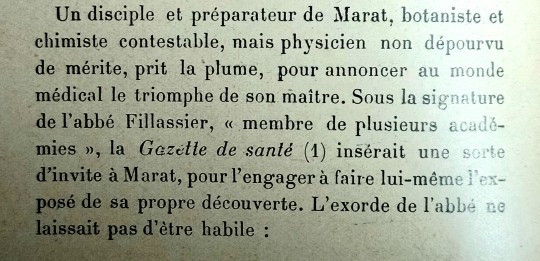
"A disciple and coach of Marat, a botanist and chemist of questionable merit, but a physicist of undeniable merit, took up his pen to announce his master's triumph to the medical world. Under the signature of Abbé Fillassier, "member of several academies", the Gezette de Santé inserted a sort of invitation to Marat, urging him to make his own discovery. The abbot's exordium was very clever."
And then the text in question, written by Filassier for the Gazette:

"Five years earlier, the Marquise de L'Aubespine had been stricken with a lung disease which, as it worsened over time, was definitively considered incurable. Abandoned by all the doctors, the patient was on the verge of succumbing, when the intervention of one last doctor brought her back to health within a few weeks. Filled with gratitude for the doctor who brought her back from so far away, it is on his orders that I have the honor of writing to you, and she joins her pleas with mine to urge you, gentlemen, to spread the word about this amazing cure."
This is an excerpt from a letter, also written by Marat to the Gazette, in which he describes his healing techniques used in the Marquise's case:
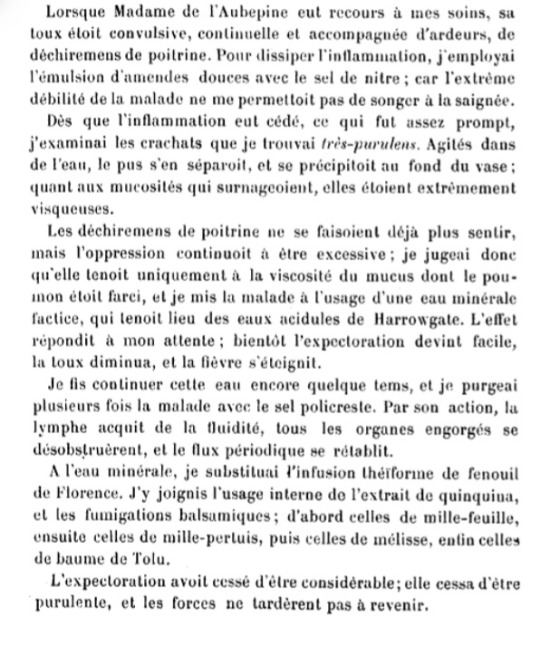

"When Madame de L'Aubespine came to me, her cough was convulsive, continuous and accompanied by burning and tearing in her chest. To dissipate the inflammation, I used an emulsion of sweet almonds with nitro salt, as the patient's extreme weakness meant that bloodletting was not an option. After the inflammation subsided, which was fairly quickly, I examined the sputum, which I found to be very purulent. Stirred in water, the pus separated and rushed to the bottom of the vessel; as for the mucus that emerged, it was extremely viscous.
The lacerations of the chest were no longer felt, but the oppression was still excessive; I therefore thought that it was only the viscosity of the mucus, of which the lung was full, and I indicated to the patient the use of an artificial mineral water, from the acidulated waters of Harrowgate. The effect corresponded to what I had expected; soon the expectoration became easy, the cough subsided and the fever disappeared.
I continued to use this water for some time and purged the patient several times with polycrest salt. As a result, the lymph became more fluid, all the congested organs were cleared and regular flow was restored.
I replaced the mineral water with an infusion of Florence fennel. I added the internal use of quinquina extract, and the balsamic fumigations: first the yarrow, then the St. John's wort (millepertuis), then the melissa, and finally the Tolu balsam.
The expectoration was no longer considerable; it stopped being purulent, and the strength soon returned.
Finally, I prescribed the patient (every morning on an empty stomach) fifty drops of essence of ambergris in a glass of cow's milk; this was enough to complete the cure; the cough, the oppression and the expectoration ceased, and the patient regained her appearance, her freshness, her cheerfulness. Today, Madame de L'Aubespine's health is so good that she doesn't even need a diet."
Considering that at this time Marat had been employed as a doctor in the body of guards of Monsieur le Comte d'Artois - which he most likely achieved through the intermediary or at the very least the influence of the Marquise de L'Aubespine (niece of the Duke of Choiseul), who must have introduced Marat to these kinds of high circles - it is undeniable that he was right in the middle of the elite of Parisian medicine and could make a very comfortable living from his specialty. Apparently, he had quite a large clientele too.
However, his aristocratic clients weren't always happy with Docteur Marat's bill, as he was well aware of the type of clientele he had and therefore didn't hesitate to charge a relatively high price for his consultations. Two cases are known in which Marat's clients were dissatisfied: the first, much less serious or violent than the second, is highlighted in a letter written by the brother of the husband of one of his patients.
A lawyer living in Lyon, M. Roubaud, wrote to his brother, a medical student in Paris, to go to Dr. Marat, to get a consultation from him on the subject of his wife's illness. Marat then promptly writes a letter with a series of questions aimed at finding out about the patient's condition. This medical proscription was mentioned and attached in the last post, but since I managed to find it in better quality, I'll leave it here too:
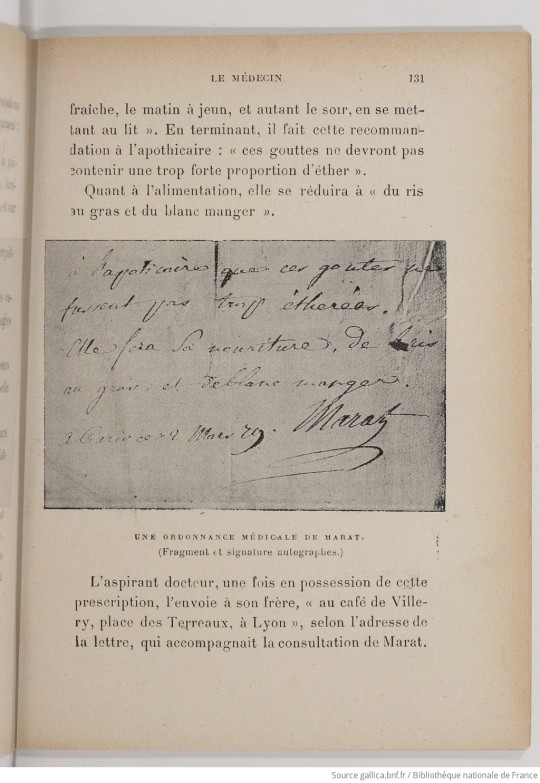
Marat also makes some recommendations to ease the patient's suffering. The letter was published under the title of Marat médecin: une consultation inédite du docteur Marat, in Journal de Médecine de Paris, Dax frères & Thiron, Clermont, oct-nov 1907. It can also be found on pg. 130-131 of Marat inconnu.
However, Roubaud doesn't seem to have been very satisfied with the price of the consultation, and wrote the following in the postscript of a letter in reply to his brother:

"Mr. Marat seems a bit expensive to me; you pay twenty-four pounds for his consultations, and the little blotter I sent you cost me twelve."
But this is far from a serious case. The second person to clearly show his dissatisfaction was the Count of Zabielo. At the end of December 1777, Marat paid a visit to Madame Courtin, a patient who was being treated for a chest illness. When he arrived, he met the Count of Zabielo, a friend of Madame Courtin's, who made him go into a neighboring room where two men and a woman were already. Together, they began to strongly reprimand the doctor and cover him with violent blows. Marat's servant at the time, Nicolas Dumoulin, was with Marat when this happened, and was also beaten. The two managed to escape under the threats of the Count of Zabielo, who had promised to spread the word that Marat "killed his patients".
That same evening, Marat and Dumoulin opened a court case against Zabielo and his other attackers at the Châtelet. The process was coordinated mainly by Moreau, the king's prosecutor, and the commissioner Thiot.
Here is the certificate from the doctors who went to assess the abrasions suffered by Marat, with supporting documents and information. This document can be found in the Archives Nationales, Y/9864 and Y/13796. Other information about the case is told in more detail on pg. 500-510 of Marat inconnu:


Despite all this, it is quite wrong to assume that Marat was the only doctor who charged a lot for his services, or that he was the doctor who charged the most. Dr. Paul Delaunay, in his Le Monde médical Parisien au dix-huitième siècle (1906), for example, reports that other doctors with aristocratic clientele in the Ancien Régime, such as Dr. Antoine Portal, charged around twelve francs per visit and forty-eight francs per consultation.
One of Marat's most notorious and esteemed clients was undoubtedly Romé de l'Isle, a crystallographer. The two apparently met through one of Marat's close friends, Philippe Rouse Roume de Saint-Laurent, with whom he corresponded. Marat cured Romé of an eye disease in 1783 by means of electrification and, from then on, the two may have become good friends. In this letter that Marat wrote to Roume de Saint-Laurent on September 26, 1783 [pg.221], he tells his friend about his meeting with Romé:
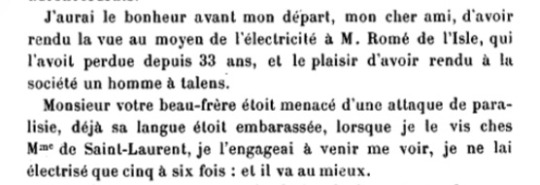
"I shall have the happiness before my departure, my dear friend, of having restored sight by means of electricity to M. Romé de l'Isle, who had lost it 33 years ago, and the pleasure of having restored to society a man of talent. Your brother-in-law was threatened with an attack of paralysis, his tongue was already embarrassed, when I saw him at Madame de Saint-Laurent's, I urged him to come and see me, I only electrified him five or six times: and he is doing well."
Later, Romé proved to be a great supporter and respecter of Marat's academic and scientific work. In 1786, for example, he agreed to act as an intermediary between Marat and the Berlin Academy, apparently in a letter dated May 6 [p. 91]. In 1788, Romé also showed support for Marat's physical observations. The admiration is mutual, as Marat cites Romé as a "distinguished scholar" in the last letter of his Charlatans modernes (1791). I can't attach any more images to this post, but the excerpt where Marat quotes Romé is on p. 225:
"Where do you think they got this magnificent system from? They took it word for word from the treatise on weights and measures of the Ancients, published by Romé de Lisle, a distinguished sage, whose name they were zealous to silence, in order to plunder it with impunity after his death, after having persecuted him all his life."
From all this, it is possible to conclude that Doctor Marat's clientele was, at least for a good period of his life, essentially made up of wealthy and noble people, despite the fact that Marat himself was never really considered a nobleman. It is certainly ironic that, during the revolution, these people were constantly attacked by Marat (the Count d'Artois, for example). Despite the dissatisfaction of some of his clients about the prices he charged for consultations and the virulence of his opponents who tried to boycott his medical career, Marat undoubtedly shows himself to be a very competent clinician and a born observer. In the pre-revolutionary era, he often signed his letters with 'Le Docteur Marat', which changed after the revolution and especially after the founding of L'Ami du Peuple. However, even so, Dr. Marat did not cease to exist from 1789 onwards: sometimes Marat would sign his letters referring to himself as 'docteur en médecine', or also as 'Marat, docteur en médecine et l'ami du peuple'. In the future, I plan to write a post attaching some of the letters he signed like this.
That's how I end this post. Let me know if you have any questions about the sources used, and please feel free to send me an ask! :)
Vitam impendere vero.
* First of all, I beg your pardon if any information about the medical procedures is poorly explained or represented in the translations. I'm not a medical expert - I'm just completely fascinated by Marat's medicine, but I'm a long way from understanding anything about this area of knowledge.
* I've taken a lot of inspiration from the biographies of Olivier Coquard and Docteur Cabanés to write this post, and so I'm being careful to design them the credits for most of the things I've written and the information I've used! :)
35 notes
·
View notes
Text
A pox on ye !
Surgeons on board British warships in the 18th century could double their monthly salary of 5 ₤ per 100 cases of venereal disease treated. This additional compensation was financed by fines levied on crew members who contracted gleet (gonorrhoea) or pox (syphillis). However, additional money was also available for unscrupulous doctors who treated the symptoms rather than the disease. In such cases, the patient was declared "clear" as soon as the symptoms had subsided. Only when the disease inevitably reappeared later was appropriate treatment given (with an additional fine, of course), along with the wise advice to avoid a Fire Ship (a lady with such a disease).
However, by the end of the 18th century, surgeons were forbidden to charge extra money and had to treat the men as such. Because this additional payment often caused the men to say nothing at all and to try to treat themselves with very questionable treatments. These included drinking tar water or coating their "best friend" with tar and then treating them with fire or even injecting them with vinegar water. It only brought more pain and death than necessary, hence the free treatment afterwards and the constant hope that the surgeon really knew what he was doing.
99 notes
·
View notes